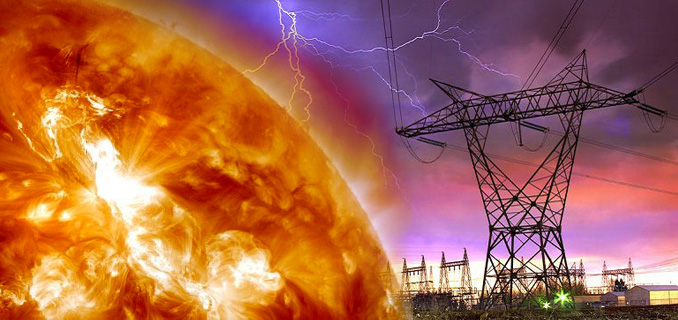EMP Attack and Solar Storms, Part II: Cascading Failures and Nuclear Meltdown
Source: truthistreason.net

Some time ago, we discussed the broad implications of an electromagnetic pulse (EMP) attack, such as that from an aerial detonation of a nuclear device, and the similar effects of a large solar storm or coronal mass ejection from the sun. In that discussion, we looked at the overall aspects of the crisis, including interruptions to our trucking industry, which in turn would represent a massive failure in our food, health, and fuel delivery systems. Other topics included traffic gridlock, potential vehicle failure, and briefly, what to expect after the lights go out.
In Part II of this guide, we will dive into a more technical look at what even the most minor of electrical hiccups and disturbances can do to our delicate, computerized world, as well as explore how interconnected our society truly is. However, in order to adequately set the stage for understanding the grave threat under conditions in which all of our infrastructures fall prey to simultaneous failure, it is imperative to understand that the “vulnerability of the whole — of all the highly interlocked critical infrastructures — may be greater than the sum of the vulnerability of its parts.” (1)
If a singular system goes down, it can result in a cascade of failures across the spectrum, from communications, to banking, to government services, and even water treatment and sanitation. While many articles paint a bleak overall picture of a few singular failures, there are some extremely dangerous situations that are often overlooked, especially within the oil, gas, and nuclear sectors.
Many of these modern marvels rely on remote systems to operate, acquire data, and perform mundane actions, which are not only grid-dependent, but highly sensitive to electrical disturbances. In particular, the 2008 Congressional EMP Commission thought it important to single out the growth and common infrastructural infiltration of one particular transformative technology; “the development of automated monitoring and control systems— the ubiquitous robots of the modern age known as Supervisory Control and Data Acquisition (SCADA) systems.”(1)
What is SCADA?
SCADAs are electronic control systems that may be used for data acquisition and control over large and geographically distributed infrastructure systems. They find extensive use in critical infrastructure applications such as electrical transmission and distribution, water management, and oil and gas pipelines. SCADA technology has benefited from several decades of development. It has its genesis in the telemetry systems used by the railroad and aviation industries.(1)
A broad function of a SCADA system is to remotely monitor the operational state of a physical system. It accomplishes this monitoring by providing an ongoing reporting of parameters that either characterize the system’s performance, such as voltage or currents developed in an electric power plant, flow volume in a gas pipeline, and net electrical power delivered or received by a regional electrical system, or by monitoring environmental parameters such as temperature in a nuclear power plant and sending an alarm when certain operating conditions are exceeded.
The supervisory control function of a SCADA reflects the ability of these devices to actively control the operation of the system by adjusting its input or output.
For example, should an electrical generating plant fail through loss of a critical hardware component or industrial accident, the monitoring SCADA will detect the loss, issue an alert to the appropriate authorities, and issue commands to other generating plants under its control to increase their power output to match the desired load again. All of these actions take place automatically, within seconds, and without a human being involved in the immediate control loop.1
When one of these systems malfunctions, they often require a technician to physically go to some remote location and reset it, power it back on, diagnose the issue, or flip a switch. While there are entire career fields devoted to resetting these systems, there are only so many technicians in a given geographical region. As we have witnessed time and time again, both the private and public sector have had difficulty in staffing responses to natural disasters that only effect a relatively small region, such as hurricanes, so with a robust EMP attack or severe electromagnetic disturbance (EMD), there are likely not enough technicians and engineers in the entire world to handle the issue in a timely manner.
If the electromagnetic disturbance impacted a large swath of the United States, it could take years before workers are able to respond to every remote terminal, let alone handle the logistics of commanding a small army of technicians having little to no communication, hampered fuel delivery systems, and a society that can barely handle one week without power, as seen during both Hurricane Sandy and Katrina.
The Consequences
The real dangers arise when extrapolating what will happen when oilfield pipelines fail to open and close properly, when nuclear power plants can no longer regulate their temperatures, and waste water treatment plants fail to deliver. Oil and gas refineries, compressors, pipelines, nuclear reactors, and electrical plants will cease to operate due to a multitude of cascading failures, which in turn will shut down most powered communication, as well as cause extensive physical damage.
2008 EMP Commission:
To provide insight into the potential impact of these EMP-induced electronic system malfunctions, one can consider the details of historical events. In these cases, similar (and arguably less severe) system malfunctions have produced consequences in situations that are far too complex to predict beforehand using a model or analysis.
Another important observation is that these incidents are seldom the result of a single factor. Rather they are a combination of unexpected events that, only in hindsight, are easily related to the impact. This is not surprising given the complexity of the systems involved.
Carlsbad Pipeline Incident
On August 19, 2000, an explosion occurred on one of three adjacent large natural gas pipelines near Carlsbad, New Mexico, operated by the El Paso Natural Gas Company. The pipelines supply consumers and electric utilities in Arizona
and Southern California. Twelve people, including five children, died as a result of the explosion. The explosion left an 86-foot-long crater. After the pipeline failure, the Department of Transportation’s Office of Pipeline Safety (OPS) ordered the pipeline to be shut down. The explosion happened because of failures in maintenance and loss of situational awareness, conditions that would be replicated by data acquisition disruptions caused by an EMP event.
Pembroke Refinery Incident
On July 24, 1994, a severe thunderstorm passed over the Pembroke refinery in the United Kingdom. Lightning strikes resulted in a 0.4 second power loss and subsequent power dips throughout the refinery. Consequently, numerous
pumps and overhead fin-fan coolers tripped repeatedly, resulting in the main crude column pressure safety valves lifting and major upsets in the process units in other refinery units, including those within the fluid catalytic cracking complex (FCC).
There was an explosion in the FCC unit that shook windows, doors, and damaged properties within a 10 mile radius, and was heard up to 40 miles away. The explosion was caused by flammable hydrocarbon liquid continuously being pumped into a process vessel that, because of a valve malfunction, had its outlet closed. The control valve was actually shut when the control system indicated that it was open. The malfunctioning process control system did not allow the refinery operators to contain the situation.
As a result of this incident, an estimated 10 percent of the total refining capacity in the United Kingdom was lost until this complex was returned to service. The business loss is estimated at $70 million, which reflects 4.5 months of downtime. The disturbances caused by the lightning strikes — power loss and degradation — would also result from an EMP event.
When even a handful of these critical infrastructures go down, it places other systems that might have not been afflicted into overload states in an effort to make up for the loss, which can result in further failures.
Once electrical generation is down, communication is lost. Those not in the directly-impacted areas will still experience the ill effects of these failures due to so many systems being interwoven; emergency services and hospitals will only operate for a few days on back-up power and limited fuel supplies, and once the banks close their doors due to their main networks and finance hubs being hampered, the entire economy ceases to exist for all general intents and purposes. ATMs and credit would be worthless, if functional at all.
[...]
Read the full article at: truthistreason.net
Tune into Red Ice Radio:
Jay Weidner, Barbara Hand Clow & Lawrence E. Joseph - 2012 Roundtable Special
Will Hart - Solar Flare Apocalypse, Accelerated Natural Disasters & Evolution
Paul A. LaViolette - Earth Under Fire, Galactic Superwaves & Subquantum Kinetics
Micheal Sunanda - Extreme Weather, Global Warming & Permaculture
Robert Schoch - The Mystery of the Sphinx, Forgotten Civilization & Catastrophic Solar Outbursts






















